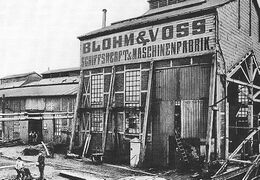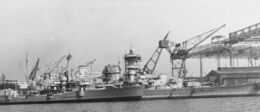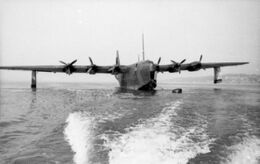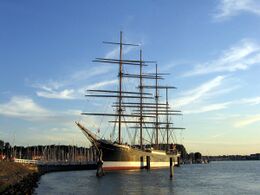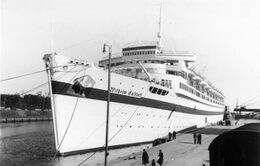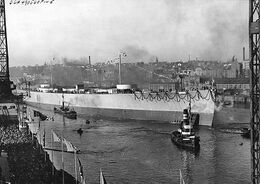Company:Blohm+Voss
 | |
| Type | Private, KG |
|---|---|
| Industry | Shipbuilding |
| Founded | 1877 |
| Founder | Hermann Blohm and Ernst Voss |
| Headquarters | Hamburg, , Germany |
Area served | Worldwide |
Key people | Dieter Dehlke, Ralph Petersen, Klaus Borgschulte |
| Products | Ships & Yachts |
| Services | Repair, Refit & New Construction |
Number of employees | 689 (2018) |
| Parent | Lürssen |
| Website | blohmvoss.com |
Blohm+Voss (B+V), also written historically as Blohm & Voss, Blohm und Voß etc., is a Germany shipbuilding and engineering company, Founded in Hamburg in 1877 to specialise in steel-hulled ships, its most famous product is the World War II battleship Bismarck.
In the 1930s its owners established the Hamburger Flugzeugbau aircraft manufacturer which, shortly before the outbreak of World War II, adopted the name of its parent company.
Following a difficult period after the war, B+V revived its fortunes by becoming a public company and allowing a change of ownership. In 2016 it became a subsidiary of Lürssen and continues to supply both the military and civil markets. The company also carries out related activities, managing a dockyard in Hamburg and undertaking maintenance and repair of large cruise ships. Since the acquisition, it has been concentrated in three areas: warships (new construction), cruise ships and merchants (repairs) and "yacht refitting". [1] The company has been in operation, building ships and other large machinery, more or less continuously for Template:Sum years.
History
Early years
Blohm & Voss was founded on 5 April 1877, by Hermann Blohm and Ernst Voss (or Voß) as a general partnership, to build steel-hulled ships. It established a shipyard on the island of Kuhwerder, near the Free and Hanseatic City of Hamburg, covering 15,000 m² with 250 m of water frontage and three building berths, two suitable for ships of up to 100 metres length. The company name was shown with the ampersand, as B&V, until 1955.
Shipbuilding was at that time dominated by the British, with even German customers preferring to buy from them. Initial business was confined to ship repairs, although B&V managed to build and later sell a three-masted barque, the National. Eventually the first new-build order arrived for a small cargo paddle-steamer, the Burg, and the business took off. By 1882, the company had gained a reputation for quality and punctuality and was prospering.[2]
Initially, their products were steel-hulled sailing ships designed for long sea voyages. At that time steamships had a relatively short range, while many of the advantages of steel construction still applied to sailing ships as much as to steam. The company built its first steamship in 1900, while still continuing to build sailing ships until the late 1930s.[citation needed]
The Nazi era, 1933-1945
When Hermann Blohm died, his two sons Rudolf and Walther took over. Ernst Voss left soon afterwards. By this time the company was in financial crisis, so the Blohm brothers diversified into aircraft, setting up the Hamburger Flugzeugbau (see below) in the summer of 1933.[3]
With the rise of the Nazi Party to power in 1933, Germany began to rearm and both companies became increasingly involved in the programme. The shipyard built both civilian craft and warships for the government, including the battleship Bismarck, before manufacturing U-boats in quantity.
From July 1944 to April 1945 the company used inmates of its own concentration subcamp at its shipyard in Hamburg-Steinwerder, a subcamp of Neuengamme concentration camp.[4] A memorial stands on the site of the camp and the company continues to pay an undisclosed amount to the Fund for Compensation of Forced Laborers.[5]
Steinwerder was badly damaged during the bombing of Hamburg in World War II and at the end of it, shipbuilding was forbidden.[6]
Hamburger Flugzeugbau
In 1933 Blohm & Voss was suffering a financial crisis from lack of work. Its owners, brothers Rudolf and Walther Blohm, decided to diversify into aircraft manufacture, believing that there would soon be a market for all-metal, long-range flying boats, especially with the German state airline Deutsche Luft Hansa. They also felt that their experience with all-metal marine construction would prove an advantage. They formed the Hamburger Flugzeugbau that summer.[7][3]
Most of the aircraft built by HFB/B&V would in fact be other companies' designs and major subassemblies, contracted under license, including tens of thousands of aircraft each for Dornier, Heinkel, Junkers and Messerschmitt.[3] Alongside its volume manufacturing the company also maintained its own design office and workshops which continued to develop and build new types throughout the company's life. The first planes it produced were designated with the official RLM company code "Ha".
The aircraft produced by Hamburger Flugzeugbau were still commonly associated with Blohm & Voss and this was causing confusion, so in September 1937 Hamburger Flugzeugbau was renamed Abteilung Flugzeugbau der Schiffswerft Blohm & Voss and the RLM changed its company code to "BV".[8]
Its most significant designs were flying boats, mainly used by the Luftwaffe for maritime patrol and reconnaissance. Most numerous was the BV 138 Seedrache (initiated as the Ha 138), a twin-boom trimotor, while the BV 222 Wiking was much larger. Largest of all was the BV 238 prototype, the largest aircraft built by any of the Axis forces. Other notable types include the asymmetric BV 141, which was built in moderate numbers but did not enter production.
At the end of the war, aircraft production was shut down. Hamburger Flugzeugbau GmBH (HFB) would re-emerge in 1956, still under the ownership of Walther Blohm but no longer connected to B+V. It underwent various further changes of ownership and company name,[9] eventually becoming part of Airbus.
Postwar
After the Second World War, the British continued to demolish the shipyards of Steinwerder and B&V, unable to restart shipbuilding work, all but ceased to exist.
In 1950 B&V created a new subsidiary company, Steinwerder Industrie AG, to manufacture machinery and boilers. Its shipyard fortunes began to revive in 1952 when the new company was allowed to restart ship repair work and the City of Hamburg guaranteed it credit. By 1953 some 900 workers were back in employment.[6] The building of ships would later also be allowed again. During this period of resurrection the level of investment required meant that B&V moved out of private hands and became a publicly quoted company, 50% owned by Phoenix-Rheinrohr AG, itself soon to be consolidated into the Thyssen Group.[10] Even so, B&V would never regain its former size. In 1966 it took over neighbouring shipbuilder H. C. Stülcken Sohn.[11]
For many of its new warships, B&V developed a modular approach to the equipment fit which they called Mehrzweck-Kombination (multipurpose-combination) or MEKO, which was intended to reduce costs and ease maintenance. Several classes of MEKO ship have been built, some in significant numbers. They have been sold both to the German Navy and for export.
During the postwar years, B+V built oil rigs and developed a market for other offshore products such as support ships and pipelines.[12][13][14] The company has also built ships for numerous commercial customers, including luxury yachts. The Eclipse, built for Russian billionaire Roman Abramovich, is 162 metres (531 ft 6 in) in length making it the second longest private yacht in the world. B+V still administers the Elbe 17 dry dock at Hamburg.
When Thyssen AG and Krupp merged in 1999, B+V became a subsidiary of ThyssenKrupp Marine Systems.
In December 2001 Blohm+Voss, Nordseewerke and Friedrich Lurssen Werft were awarded the contract to build the first five K130 Braunschweig-class corvettes. The first of them, the Braunschweig was built at Blohm+Voss, launched in April 2006 and commissioned in April 2008.[15] Several problems with the equipment fit delayed commissioning, and the last was commissioned in 2013.[16][17]
In 2011 ThyssenKrupp agreed the sale of the Blohm+Voss civil shipbuilding division to British investment company STAR Capital Partners.[18][19] The military division remained with ThyssenKrupp.[20]
In October 2016, regulatory approval was given for Lürssen to acquire Blohm+Voss from STAR Capital Partners.[21][22] In April 2017 the company announced that it would be laying off about 300 employees.[23]
In September 2017, the German Navy commissioned the construction of five more K130 corvettes by a consortium of North German shipyards including ThyssenKrupp Marine Systems, Blohm+Voss, and the German Naval Yards in Kiel. The Lürssen Group, which would be the main contractor in the production of the vessels, distributed its work between the two sites at Wolgast and B+V Hamburg. The contract is worth around 2 billion euros.[24][25] In April 2018 the German government announced the detailed worksharing arrangements under which the ships would be built.[26][27]
The German government also intends to build four new MKS 180 ships. Lürssen submitted a joint proposal with ThyssenKrupp, but in March 2018 it was turned down. [28][29] Prior to this, ThyssenKrupp and Lürssen had been awarded a contract to build 4 Baden-Württemberg-class frigates and delivered questionable built ships, that the German navy returned the ships to the builder in December 2017 for refit. There had been similar problems with the first set of K130 Braunschweig-class corvettes delivered by the companies. [28][30][31]
However, prior to being acquired, Blohm+Voss had allied with the Damen Group to also submit a proposal to build the MKS 180, and that proposal was still under consideration as of 23 March 2018. [32]
Due the decision of this contract, ThyssenKrupp wants to sell its military naval systems yards in Hamburg, Kiel and at Emden. [33]
Ships built
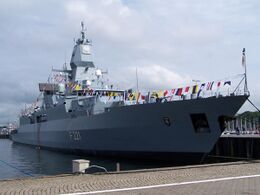
Blohm & Voss was established in the days of sail and, although it built ships with steel hulls from the very first, it did not produce a significant steamship until 1900. Of the many hundreds of ships built by B+V, notable examples include:
Tall ships
- Flying P-Liners, including Petschili (1903), Pamir (1905), Passat (1911), Peking (1911), Pola (1916) and Priwall (1917)
- Prinzess Eitel Friedrich (1909) (later Dar Pomorza)
- Gorch Fock class of three-masted barques and school ships, between 1933 and 1938.
Ocean liners and other passenger ships
- Prinzessin Victoria Luise (1900), a Hamburg America Line ship, the first ship built exclusively for cruising
- RMS Majestic (1914), a White Star Line liner and the largest ship in the world until the completion of the Normandie in 1935
- SS Leviathan (1914), a United States Lines liner and sistership to the RMS Majestic. Scrapped in 1938.
- SS Cap Arcona (1927), a Hamburg Süd liner sunk with great loss of life near the end of the Second World War
- SS Monte Cervantes (1927), a Hamburg Süd liner lost near Tierra del Fuego in 1930
- SS Europa (1928), a Norddeutscher Lloyd liner and Blue Riband winner
- MV Monte Rosa (1930), a passenger liner and cruise ship that would become better known as the troopship Empire Windrush
- MV Monte Pascoal (1930), a passenger liner and cruise ship. Sister ship of Monte Rosa and Monte Cervantes
- SS Potsdam (1935), a Norddeutscher Lloyd turbo-electric liner that served as an Allied troopship and then the Pakistani pilgrim ship Safina-E-Hujjaj.
- TS Pretoria (1936) and TS Windhuk (1936), Deutsche Ost-Afrika Linie passenger cargo liners.
- MV Wilhelm Gustloff (1937), Kraft durch Freude (Strength Through Joy) cruise ship and the world's worst maritime disaster, in number of human loss, at all times
- MV Aurora (1955) As the Wappen Von Hamburg. It was the first luxury liner to be built after World War II.
- MV Explorer (2001), used by the Semester at Sea university study abroad program
Private yachts
- A – 119 m (390 ft) owned by Russian billionaire Andrey Melnichenko
- Dubai – owned by the ruler of the Emirate of Dubai and the Prime Minister of the United Arab Emirates, Sheikh Mohammed bin Rashid Al Maktoum
- Eclipse – the second-largest private yacht, owned by Russian billionaire Roman Abramovich.
- Enigma – a yacht ordered by Azcarraga, later owned by Larry Ellison and Aidan Barcaly.
- Grille – built as the German state yacht (1935), converted to minelayer at the beginning of World War II, later reconverted to state yacht of Nazi Germany, Hitler's official maritime conveyance.
- Lady Moura – owned by Saudi billionaire Dr Nasser al-Rashid. [34]
- MV Savarona – built for an American heiress in 1931. Later the Turkish Presidential yacht and now a charter yacht. Still among the largest yachts, at 446 feet (136 m) long.
Warships
Pre-dreadnought warships
- SMS Kaiser Karl der Grosse, battleship – first battleship to be built in the yard[35][36]
Warships of World War I
- SMS Glyndwr, light seaplane carrier converted from a merchant ship
- SMS Von der Tann, battlecruiser
- SMS Goeben, battlecruiser
- SMS Moltke, battlecruiser
- SMS Scharnhorst, armoured cruiser
- SMS Seydlitz and SMS Derfflinger, battlecruisers that were heavily damaged in the Battle of Jutland; both stayed afloat and brought their crews home.
Warships of World War II
- Admiral Hipper, heavy cruiser
- Bismarck, battleship
- Cetatea Albă, minelayer (Romanian Navy)[37]
- Many Type VII, Type XVII, Type XXI and Type XXVI U-boats
Modern warships
Ships built using the MEKO system are listed at MEKO.
Other modern warships designed and built by B&V include:
- Rheinland-Pfalz (F209), a Bremen-class frigate
- Brandenburg (F215), the first Brandenburg-class frigate
- Sachsen (F219), the first Sachsen-class frigate
- Z28-class patrol boats for the Argentine Coast Guard
References
Notes
- ↑ https://www.mopo.de/hamburg/erste-bilanz-nach-uebernahme-alles-neu-bei-traditionswerft-blohm-voss-30085876
- ↑ "End of an era for Germany’s most famous shipyard". 2011-08-31. http://www.motorship.com/news101/ships-and-shipyards/end-of-an-era-for-germanys-most-famous-shipyard.
- ↑ 3.0 3.1 3.2 Pohlmann (1979).
- ↑ The camp Blohm & Voss is listed as No. 550 Hamburg in the official German list (List in German)
- ↑ Herbert Diercks, Der Hamburger Hafen im Nationalsozialismus, 2008
- ↑ 6.0 6.1 Henry Burke Wend; Recovery and Restoration: U.S. Foreign Policy and the Politics of Reconstruction of West Germany's Shipbuilding Industry, Praeger, 2001, pp.196–198.
- ↑ Amtmann (1998)
- ↑ B+V Geschichte v. 1933-1938 -Die Rüstungskonjunktur ab 1933
- ↑ Pohlmann (1979), 1982 edition, Page 242.
- ↑ Hamburg Journal, Part 2.
- ↑ Mauerblümchen ist jetzt die Regierung ("Wallflower is Now the Boss"), Der Spiegel, 21 February 1966, pp.25-26.
- ↑ Cape Town shipyard busy with Scarabeo 3 upgrades, MarineLog (retrieved 26 April 2017)
- ↑ Semi submersible drill rig Chris Chenery, Oil Rig Photos (retrieved 26 April 2017)
- ↑ Offshore Units, Blohm+Voss (retrieved 26 April 2017)
- ↑ "K130 Braunschweig Class Corvette". Naval Technology. https://www.naval-technology.com/projects/k130corvette/. Retrieved 30 April 2018.
- ↑ "K130 Braunschweig class" (in en-gb). Navy Recognition. http://www.navyrecognition.com/index.php/world-naval-forces/west-european-navies-vessels-ships-equipment/german-navy-marine-germany-vessels-ships-equipment/corvettes-and-opv/1189-k130-braunschweig-class-corvette-korvette-f260-magdeburg-f261-erfurt-f262-oldenburg-f263-ludwigshafen-am-rhein-f264-german-navy-deutsche-marine-tkms-blohm-voss-datasheet-pictures-photos-video-specifications.html. Retrieved 1 May 2018.
- ↑ "Milliardenprojekt Korvette 130: Pannenserie reißt nicht ab - Marineinspekteur fordert schärfere Kontrolle" (in German). Norddeutcher Rundfunk via PressPortal. 20 June 2011. http://www.presseportal.de/pm/6561/2065764/milliardenprojekt-korvette-130-pannenserie-reisst-nicht-ab-marineinspekteur-fordert-schaerfere. Retrieved 14 May 2015.
- ↑ Bryant, Chris. "ThyssenKrupp sells ‘mega-yacht’ division". FT.com. Financial Times Limited. http://www.ft.com/cms/s/0/276446d0-24ab-11e1-ac4b-00144feabdc0.html#axzz1gKKFcOYh. Retrieved 12 December 2011.
- ↑ "STAR Capital Partners buys Blohm & Voss’ civil business". SuperYachtTimes.com. SuperYachtTimes.com. http://www.superyachttimes.com/editorial/14/article/id/7606. Retrieved 12 December 2011.
- ↑ Conrad Waters (Ed.); Seaforth World Naval Review 2013, Seaforth, 2012, p.134.
- ↑ "Breaking news: Lürssen acquires Blohm + Voss". superyachttimes.com. 28 September 2016. http://www.superyachttimes.com/yacht-news/breaking-news-a-new-future-for-luerssen/. Retrieved 28 September 2016.
- ↑ German Fair Trade Commission approves Blohm+Voss Acquisition, B+V web site, 31 October 2016. (Retrieved 17 April 2017).
- ↑ "Dramatic year for German shipbuilding" (in en). The Motorship. 20 April 2017. http://www.motorship.com/news101/ships-and-shipyards/dramatic-year-for-german-shipbuilding.
- ↑ "Germany awards €2.4bln contract for five new K130 corvettes". Naval Today. https://navaltoday.com/2017/09/13/germany-awards-e2-4bln-contract-for-five-new-k130-corvettes/.
- ↑ "Riesenauftrag von Bundeswehr: Blohm+Voss auf Jahre gerettet" (in de). Abendblatt. https://www.abendblatt.de/hamburg/article211919755/Riesenauftrag-von-der-Bundeswehr-Blohm-Voss-auf-Jahre-gerettet.html. Retrieved 14 September 2017.
- ↑ "Four Shipyards Agree to Build New German Corvettes". www.defense-aerospace.com. April 9, 2018. http://www.defense-aerospace.com/articles-view/release/3/192245/four-shipyards-agree-to-build-new-german-corvettes.html.
- ↑ "Wie Blohm+Voss vom Bau neuer Korvetten profitiert" (in de-DE). Hamburger Abendblatt. 6 April 2018. https://www.abendblatt.de/wirtschaft/hafen-und-schifffahrt/article213939181/Wie-Blohm-Voss-vom-Bau-neuer-Korvetten-profitiert.html.
- ↑ 28.0 28.1 "ThyssenKrupp blocked from warship tender". Handelsblatt Global Edition. 2 March 2018. https://global.handelsblatt.com/companies/thyssenkrupp-blocked-warship-tender-893609.
- ↑ Behling, Frank (1 March 2018). "TKMS und Lürssen sind bei MKS180 raus" (in de). Kieler Nachrichten. http://www.kn-online.de/Nachrichten/Wirtschaft/Marineschiffbau-TKMS-und-Luerssen-sind-bei-MKS180-raus.
- ↑ "Germany: the MKS-180 decision, an earthquake in naval yards!" (in fr-FR). DefenceChronicles. 5 March 2018. https://www.defencechronicles.eu/germany-the-mks-180-decision-an-earthquake-in-naval-yards/.
- ↑ "Germany returns lead F125 frigate to builder, report". Naval Today. 22 December 2017. https://navaltoday.com/2017/12/22/germany-returns-lead-f125-frigate-to-builder-report/.
- ↑ Sprenger, Sebastian (23 March 2018). "Emerging German-Dutch naval tie-up has industry abuzz". Defense News. https://www.defensenews.com/industry/2018/03/23/emerging-german-dutch-naval-tie-up-has-industry-abuzz/.
- ↑ "Thyssenkrupp könnte seine Werften verkaufen" (in DE). Handelsblatt. 8 June 2018. http://www.kn-online.de/Nachrichten/Wirtschaft/Thyssenkrupp-koennte-seine-Werften-verkaufen.
- ↑ http://www.superyachtfan.com/superyacht_lady_moura.html
- ↑ Gröner, Erich (1990). German warships, 1815-1945. Annapolis: Naval Institute Press: Naval Institute Press. p. 15. ISBN 978-0-87021-790-6.
- ↑ Hildebrand, Hans H; Röhr, Albert; Steinmetz, Hans-Otto (1993). Die Deutschen Kriegsschiffe (Volume 5 ed.). Ratingen, Germany: Mundus Verlag. p. 39.
- ↑ Earl Thomas Allnutt Brassey, Brassey's Annual: The Armed Forces Year-book, Volume 58, Praeger Publishers, 1947, p. 259
Bibliography
- Amtmann, Hans; The Vanishing Paperclips, Monogram, 1988.
- Meyhoff, Andreas. Blohm & Voss im »Dritten Reich«, Eine Hamburger Großwerft zwischen Geschäft und Politik (Hamburger Beiträge zur Sozial- und Zeitgeschichte, Band 38) (in German). Hamburg, Germany: Forschungsstelle für Zeitgeschichte in Hamburg, 2001. ISBN:3-89244-916-3.
- Pohlmann, Hermann. 'Chronik Eines Flugzeugwerkes 1932-1945. B&V - Blohm & Voss Hamburg - HFB Hamburger Flugzeugbau (in German). Motor Buch Verlag, 1979 ISBN:3-87943-624-X.
- Prager, Hans Georg and Bishop, Frederick A.(Transl.). Blohm + Voss: Ships and Machinery for the World. London: Brassey's Publishers Limited, 1977. ISBN:0-904609-14-6.
- Witthöft, Hans J. Tradition und Fortschritt - 125 Jahre Blohm + Voss (in German). Koehlers Verlag, 2002. ISBN:3-7822-0847-1.
External links
| Wikimedia Commons has media related to Blohm+Voss. |
- Company history (in English)
- Company history (in German)
- Aviso Grille - Hitler's War Yacht - Revel Barker
- 3 original wartime color slides showing the 222 Viking in 1942
- Documents and clippings about Blohm+Voss in the 20th Century Press Archives of the ZBW
